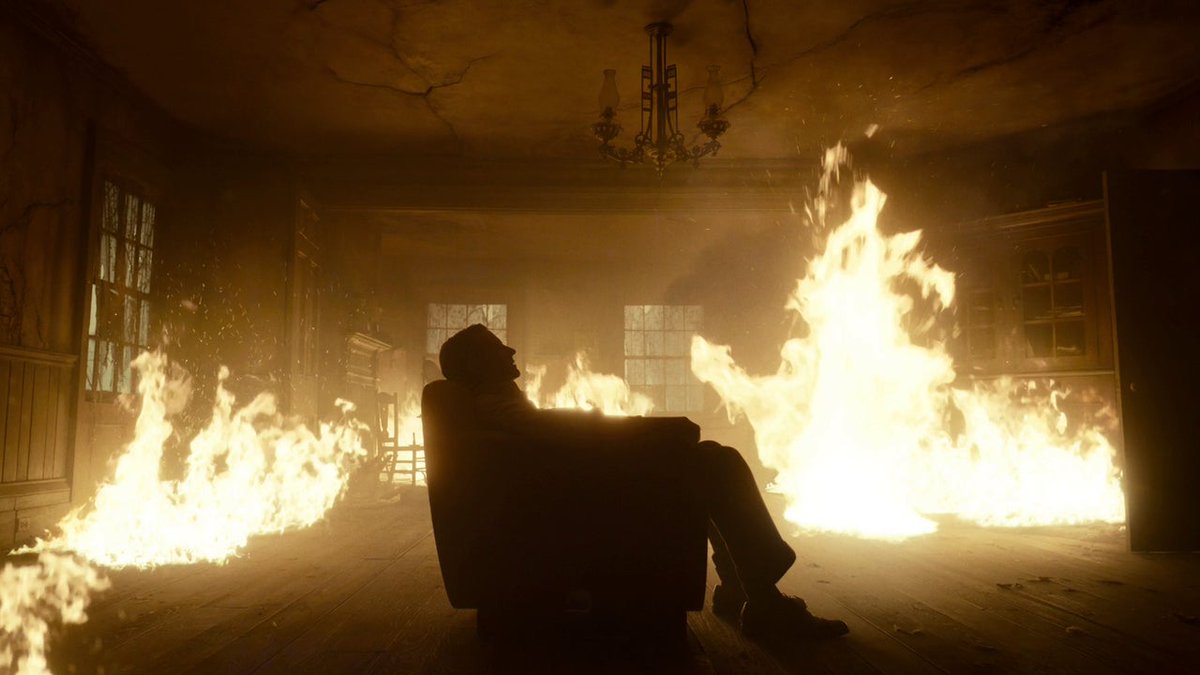
Nightmare Alley is merciless. It’s not really a horror movie, and it’s not really a thriller. It’s basically a film noir, but one without a “macguffin” – the thing that everyone in the story wants but not really what the movie is about. It is unsparing in its depiction of disreputable people doing disreputable things. It’s a lot like the “geek show” we see near the beginning of the film in which a man bites the head off a live chicken.
What Nightmare Alley lacks in compelling characters it makes up in mood and production design. As usual, Guillermo del Toro has crafted a beautifully macabre movie world. It’s all Streamline Moderne style. The carnival setting in the first half of the film is decrepit, like all traveling carnivals, but it’s highlighted by Moderne touches like fine neon tubes on the carnival gateway or the warp of an electric chair gag. Once the story moves to the city, the settings become more polished, and there are more of those Streamline Moderne flourishes. In moments when the story sags and in moments when awful things suddenly happen, those embellishments keep your eyes glued to the screen.
I wanted to spend more time in this narrative world, because it was beautiful to look at, and because the story would have benefitted from more time spent with this cavalcade of characters. Nightmare Alley is two and half hours long, but everything in it still feels abbreviated. With the exception of Cate Blanchett’s “Lilith” (a neon tube), no one’s motivations are clear. It’s not that you don’t understand what people are doing. It’s the “why” that gets lost. Rooney Mara, Toni Collette, and David Strathairn especially do a great job of communicating depths to their characters that the screenplay does not plumb.
Bradley Cooper is at the center of this story, playing Stanton Carlisle and attempting more accents than the cast of House of Gucci. I think at one point he tries “Southerner with a cold” for a while. In many ways, he’s a classic film noir character – a man with a dark past on the run trying to survive getting caught up with all the wrong people. This could have been a case of the events slowly revealing more of this con man who is so good at knowing the desires and fears of others that he is ignorant of his own psyche. It could have been, but the revelations about his character’s past—and really, using the term “revelation” is a bit of a stretch—are so ham-fisted, it’s difficult to believe them. For a movie that is in many ways about psychology, it’s all rather flimsy.
del Toro has always been at his best when he lets symbolism rule the day. He excels at finding the unsettling and exciting aspects of the more spiritual or mythological aspects of how people make sense of the world. The point of Nightmare Alley, if there is one, is that all that symbolism is bunk; people are, at best, rubes, and likely just beasts willing to do anything to dominate others; and the only freedom is found in owning up to our inherent monstrosity. Yeah, sure, we’re all sinners, we’re all fearful and apt to be taken in by con artists, and symbolism can be used disingenuously. But, mercy, that’s not all there is to us.
I am wary of making the classic mistake of equating the depiction of a depraved man as an endorsement of the things he does and believes. There is a way to see Nightmare Alley as a kind of Twilight Zone-esque comeuppance for Stanton and men like him who believe and act as he does. That is likely the intent of this film. But that allegorical take is boring compared to the more metaphysical, reaching-for-the-transcendent stories del Toro has told us before. The allegory also doesn’t fix the film’s character and pacing problems.
Myth trumps polemic, because myth accomplishes with greater and more persistent power what the polemic attempts. Myth invites you to believe in something stronger than what the polemic tears down, and myth has room for more than just judgement. Myths can set justice side-by-side with mercy and watch the centripetal force between the two whirl us off into unimaginable places, beyond the carnival and into the heavens from whence justice and mercy come. I know that, in part, because Guillermo del Toro has shown me that in the past with as much force as any filmmaker ever. I anticipate him showing me that again.
I recently wrote a short book about Guillermo del Toro and his films. If you would like that book, you can download it for free here.
Nightmare Alley is merciless. It’s not really a horror movie, and it’s not really a thriller. It’s basically a film noir, but one without a “macguffin” – the thing that everyone in the story wants but not really what the movie is about. It is unsparing in its depiction of disreputable people doing disreputable things. It’s a lot like the “geek show” we see near the beginning of the film in which a man bites the head off a live chicken.
What Nightmare Alley lacks in compelling characters it makes up in mood and production design. As usual, Guillermo del Toro has crafted a beautifully macabre movie world. It’s all Streamline Moderne style. The carnival setting in the first half of the film is decrepit, like all traveling carnivals, but it’s highlighted by Moderne touches like fine neon tubes on the carnival gateway or the warp of an electric chair gag. Once the story moves to the city, the settings become more polished, and there are more of those Streamline Moderne flourishes. In moments when the story sags and in moments when awful things suddenly happen, those embellishments keep your eyes glued to the screen.
I wanted to spend more time in this narrative world, because it was beautiful to look at, and because the story would have benefitted from more time spent with this cavalcade of characters. Nightmare Alley is two and half hours long, but everything in it still feels abbreviated. With the exception of Cate Blanchett’s “Lilith” (a neon tube), no one’s motivations are clear. It’s not that you don’t understand what people are doing. It’s the “why” that gets lost. Rooney Mara, Toni Collette, and David Strathairn especially do a great job of communicating depths to their characters that the screenplay does not plumb.
Bradley Cooper is at the center of this story, playing Stanton Carlisle and attempting more accents than the cast of House of Gucci. I think at one point he tries “Southerner with a cold” for a while. In many ways, he’s a classic film noir character – a man with a dark past on the run trying to survive getting caught up with all the wrong people. This could have been a case of the events slowly revealing more of this con man who is so good at knowing the desires and fears of others that he is ignorant of his own psyche. It could have been, but the revelations about his character’s past—and really, using the term “revelation” is a bit of a stretch—are so ham-fisted, it’s difficult to believe them. For a movie that is in many ways about psychology, it’s all rather flimsy.
del Toro has always been at his best when he lets symbolism rule the day. He excels at finding the unsettling and exciting aspects of the more spiritual or mythological aspects of how people make sense of the world. The point of Nightmare Alley, if there is one, is that all that symbolism is bunk; people are, at best, rubes, and likely just beasts willing to do anything to dominate others; and the only freedom is found in owning up to our inherent monstrosity. Yeah, sure, we’re all sinners, we’re all fearful and apt to be taken in by con artists, and symbolism can be used disingenuously. But, mercy, that’s not all there is to us.
I am wary of making the classic mistake of equating the depiction of a depraved man as an endorsement of the things he does and believes. There is a way to see Nightmare Alley as a kind of Twilight Zone-esque comeuppance for Stanton and men like him who believe and act as he does. That is likely the intent of this film. But that allegorical take is boring compared to the more metaphysical, reaching-for-the-transcendent stories del Toro has told us before. The allegory also doesn’t fix the film’s character and pacing problems.
Myth trumps polemic, because myth accomplishes with greater and more persistent power what the polemic attempts. Myth invites you to believe in something stronger than what the polemic tears down, and myth has room for more than just judgement. Myths can set justice side-by-side with mercy and watch the centripetal force between the two whirl us off into unimaginable places, beyond the carnival and into the heavens from whence justice and mercy come. I know that, in part, because Guillermo del Toro has shown me that in the past with as much force as any filmmaker ever. I anticipate him showing me that again.
I recently wrote a short book about Guillermo del Toro and his films. If you would like that book, you can download it for free here.

Elijah Davidson is Co-Director of Brehm Film and Senior Film Critic. Find more of his work at elijahdavidson.com.
The primary point of view in West Side Story is that of a wrecking ball, like the inverse of below-the-water shots that begin Jaws. Death is coming, this time from above.